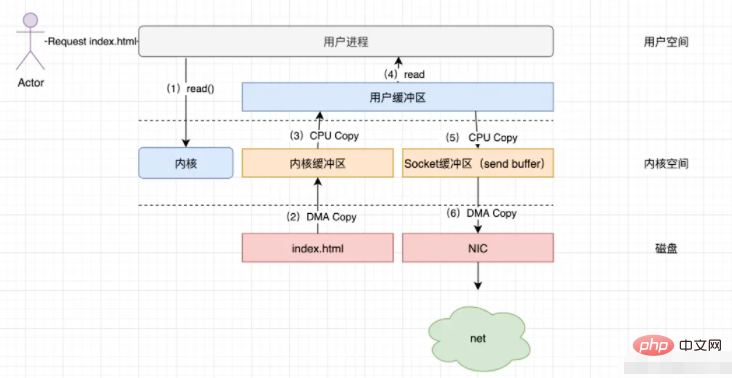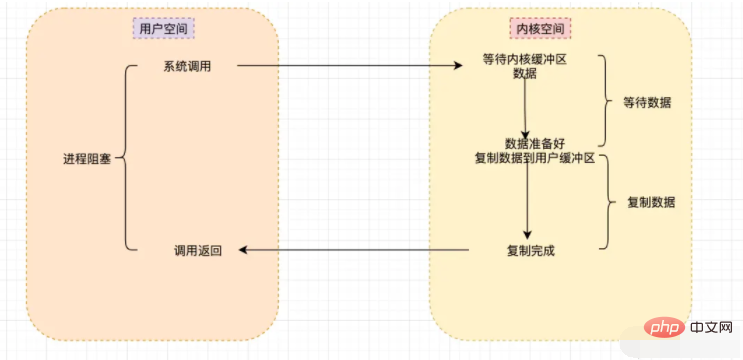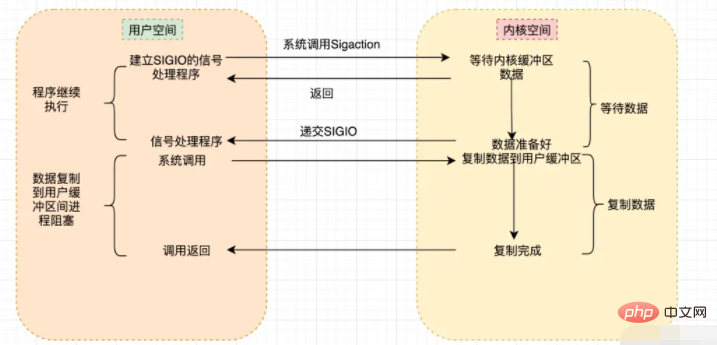What does linux io mean?
linux io refers to a file operation; in Linux, a file is a series of binary streams, so during the exchange of information, we all perform data sending and receiving operations on these streams. These operations are referred to as I/O operations; since Linux uses a virtual memory mechanism, the kernel must be requested through system calls to complete IO operations.

#The operating environment of this tutorial: linux5.9.8 system, Dell G3 computer.
What does linux io refer to?
We all know that in the Linux world, everything is a file.
And a file is a series of binary streams, whether Socket, FIFO, pipe or terminal, for us, everything is a stream.
In the process of exchanging information, we all perform data sending and receiving operations on these streams, which are referred to as I/O operations.
To read data from the stream, the system calls Read, to write data, the system calls Write.
Usually a complete IO of the user process is divided into two stages:
Disk IO:

Network IO:

The operating system and driver run in the kernel space, and the application runs in the user space. The two cannot use pointers to transfer data because The virtual memory mechanism used by Linux must request the kernel through system calls to complete IO actions.
There are three types of IO: memory IO, network IO and disk IO. Usually the IO we talk about refers to the latter two!
Why IO model is needed
If synchronization is used to communicate, all operations will be executed sequentially in one thread, so The disadvantages are obvious:
- Because synchronous communication operations will block any other operations on the same thread, only after this operation is completed, subsequent operations can be completed, so ## appears #Synchronous blocking multi-threading (Each Socket creates a thread corresponding to it), but the number of threads in the system is limited, and thread switching is a waste of time, which is suitable for situations where there are few Sockets.
The IO model needs to appear.Linux IO modelBefore describing the Linux IO model, let’s first understand the process of reading Linux system data:

Using the user requesting the index.html file as an example to illustrate

User space and kernel Space
The core of the operating system is the kernel, which is independent of ordinary applications and has access to protected memory space and all permissions to access underlying hardware devices.- In order to ensure the security of the kernel, user processes cannot directly operate the kernel. The operating system divides the virtual space into two parts, one is kernel space and the other is user space.
Process Switching
In order to control the execution of a process, the kernel must have the ability to suspend a process running on the CPU and resume a previously suspended process. execution of the process.This behavior is called process switching.So it can be said that any process runs with the support of the operating system kernel and is closely related to the kernel.
Blocking of the process
The executing process, due to certain expected events not happening, such as failure to request system resources, waiting for the completion of certain operations, new data If it has not arrived yet or there is no new work to do, the system will automatically execute the blocking primitive (Block) to change itself from the running state to the blocking state. It can be seen that the blocking of a process is an active behavior of the process itself, and therefore only a process in the running state (obtaining the CPU) can turn it into a blocked state.When the process enters the blocking state, it does not occupy CPU resources.
File Descriptor
File Descriptor is a term in computer science and is an abstraction used to express a reference to a file. concept. The file descriptor is a non-negative integer in form. In fact, it is an index value pointing to the record table of files opened by the process maintained by the kernel for each process.- When a program opens an existing file or creates a new file, the kernel returns a file descriptor to the process.
Cached IO
The default IO operation for most file systems is cached IO. The reading and writing process is as follows:Read operation: The operating system checks whether the kernel buffer has the required data. If it has been cached, it will be returned directly from the cache; otherwise, it will be returned from the disk, network card, etc. Read in, and then cached in the cache of the operating system;
Write operation: Copy data from user space to the cache of kernel space. At this time, the writing operation has been completed for the user program. As for when to write to the disk, network card, etc., it is determined by the operating system, unless the sync synchronization command is explicitly called.
Assuming that there is no required data in the kernel space cache, the user process reads data from the disk or network in two stages:
Phase One: The kernel program reads data from the disk, network card, etc. to the kernel space cache;
Phase two: The user program copies the data from the kernel space cache to user space.
Disadvantages of cached IO:
During the data transmission process, multiple data copy operations are required in the application address space and kernel space. The CPU and memory overhead caused by these data copy operations is very large.
Synchronous blocking
A user space application executes a system call, which causes the application to block and do nothing until the data is ready and the data is copied from the kernel to the user process , and finally the process processes the data. During the two stages of waiting for data and processing data, the entire process is blocked and cannot process other network IO.
- The calling application is in a state where it is no longer consuming CPU and is simply waiting for a response, so from a processing perspective this is very efficient.
This is also the simplest IO model. It is no problem to use it when there are usually few FDs and the readiness is fast.

Synchronous non-blocking
After the non-blocking system call is called, the process is not blocked, and the kernel returns to the process immediately. If the data is not ready yet, , an error will be returned.
After the process returns, it can do other things before making a system call.
Repeat the above process and make system calls in a cycle. This process is often called polling.
Polling checks the kernel data until the data is ready, then copies the data to the process for data processing.
It should be noted that during the entire process of copying data, the process is still blocked.
In this way, you can set
O_NONBLOCKto the Socket in programming.

IO multiplexing
IO multiplexing, this is the ability of the process to inform the kernel in advance, so that When the kernel finds that one or more IO conditions specified by the process are ready, it notifies the process.
Enables a process to wait on a series of events.
The current implementation methods of IO reuse mainly include Select, Poll and Epoll.

Pseudocode describes IO multiplexing:
while(status == OK) { // 不断轮询 ready_fd_list = io_wait(fd_list); //内核缓冲区是否有准备好的数据 for(fd in ready_fd_list) { data = read(fd) // 有准备好的数据读取到用户缓冲区 process(data) }}Signal driver
First we allow Socket to perform signal-driven IO , and install a signal processing function, the process continues to run without blocking.
When the data is ready, the process will receive a SIGIO signal and can call the I/O operation function in the signal processing function to process the data.
The process is as follows:
Enable the socket signal driver IO function
The system calls Sigaction Execute the signal processing function (non-blocking, return immediately)
The data is ready, generate the Sigio signal, and notify the application to read the data through the signal callback
There is a big problem with this IO method: the signal queue in Linux is limited. If it exceeds this number, the data cannot be read.

Asynchronous non-blocking
The asynchronous IO process is as follows:
When the user thread calls the
aio_readsystem call, it can start immediately To do other things, the user thread does not blockThe kernel starts the first phase of IO: preparing data. When the kernel waits until the data is ready, it will copy the data from the kernel buffer to the user buffer
The kernel will send a signal to the user thread, or call back the user thread The registered callback interface tells the user thread that the Read operation is completed
The user thread reads the data in the user buffer and completes subsequent business operations
Compared to synchronous IO, asynchronous IO is not executed sequentially.
After the user process makes the aio_read system call, regardless of whether the kernel data is ready or not, it will be returned directly to the user process, and then the user-mode process can do other things.
When the data is ready, the kernel directly copies the data to the process, and then sends a notification from the kernel to the process.
Compared with signal-driven IO, the main difference between asynchronous IO is:
- The signal driver tells us when an IO operation can be started by the kernel (the data is stored in the kernel buffer), while asynchronous IO is notified by the kernel when the IO operation has completed (the data is already in user space).
Asynchronous IO is also called event-driven IO. In Unix, a set of library functions are defined for asynchronous access to files, and a series of AIO interfaces are defined.
- Use
aio_readoraio_writeto initiate an asynchronous IO operation, and useaio_errorto check the status of the running IO operation.
The current kernel implementation of AIO in Linux is only effective for file IO. If you want to implement real AIO, you need to implement it yourself.
There are currently many open source asynchronous IO libraries, such as libevent, libev, and libuv.

Related recommendations: "Linux Video Tutorial"
The above is the detailed content of What does linux io mean?. For more information, please follow other related articles on the PHP Chinese website!

Hot AI Tools

Undresser.AI Undress
AI-powered app for creating realistic nude photos

AI Clothes Remover
Online AI tool for removing clothes from photos.

Undress AI Tool
Undress images for free

Clothoff.io
AI clothes remover

AI Hentai Generator
Generate AI Hentai for free.

Hot Article

Hot Tools

Notepad++7.3.1
Easy-to-use and free code editor

SublimeText3 Chinese version
Chinese version, very easy to use

Zend Studio 13.0.1
Powerful PHP integrated development environment

Dreamweaver CS6
Visual web development tools

SublimeText3 Mac version
God-level code editing software (SublimeText3)

Hot Topics
 1382
1382
 52
52
 Difference between centos and ubuntu
Apr 14, 2025 pm 09:09 PM
Difference between centos and ubuntu
Apr 14, 2025 pm 09:09 PM
The key differences between CentOS and Ubuntu are: origin (CentOS originates from Red Hat, for enterprises; Ubuntu originates from Debian, for individuals), package management (CentOS uses yum, focusing on stability; Ubuntu uses apt, for high update frequency), support cycle (CentOS provides 10 years of support, Ubuntu provides 5 years of LTS support), community support (CentOS focuses on stability, Ubuntu provides a wide range of tutorials and documents), uses (CentOS is biased towards servers, Ubuntu is suitable for servers and desktops), other differences include installation simplicity (CentOS is thin)
 How to install centos
Apr 14, 2025 pm 09:03 PM
How to install centos
Apr 14, 2025 pm 09:03 PM
CentOS installation steps: Download the ISO image and burn bootable media; boot and select the installation source; select the language and keyboard layout; configure the network; partition the hard disk; set the system clock; create the root user; select the software package; start the installation; restart and boot from the hard disk after the installation is completed.
 Centos options after stopping maintenance
Apr 14, 2025 pm 08:51 PM
Centos options after stopping maintenance
Apr 14, 2025 pm 08:51 PM
CentOS has been discontinued, alternatives include: 1. Rocky Linux (best compatibility); 2. AlmaLinux (compatible with CentOS); 3. Ubuntu Server (configuration required); 4. Red Hat Enterprise Linux (commercial version, paid license); 5. Oracle Linux (compatible with CentOS and RHEL). When migrating, considerations are: compatibility, availability, support, cost, and community support.
 How to use docker desktop
Apr 15, 2025 am 11:45 AM
How to use docker desktop
Apr 15, 2025 am 11:45 AM
How to use Docker Desktop? Docker Desktop is a tool for running Docker containers on local machines. The steps to use include: 1. Install Docker Desktop; 2. Start Docker Desktop; 3. Create Docker image (using Dockerfile); 4. Build Docker image (using docker build); 5. Run Docker container (using docker run).
 Detailed explanation of docker principle
Apr 14, 2025 pm 11:57 PM
Detailed explanation of docker principle
Apr 14, 2025 pm 11:57 PM
Docker uses Linux kernel features to provide an efficient and isolated application running environment. Its working principle is as follows: 1. The mirror is used as a read-only template, which contains everything you need to run the application; 2. The Union File System (UnionFS) stacks multiple file systems, only storing the differences, saving space and speeding up; 3. The daemon manages the mirrors and containers, and the client uses them for interaction; 4. Namespaces and cgroups implement container isolation and resource limitations; 5. Multiple network modes support container interconnection. Only by understanding these core concepts can you better utilize Docker.
 What to do after centos stops maintenance
Apr 14, 2025 pm 08:48 PM
What to do after centos stops maintenance
Apr 14, 2025 pm 08:48 PM
After CentOS is stopped, users can take the following measures to deal with it: Select a compatible distribution: such as AlmaLinux, Rocky Linux, and CentOS Stream. Migrate to commercial distributions: such as Red Hat Enterprise Linux, Oracle Linux. Upgrade to CentOS 9 Stream: Rolling distribution, providing the latest technology. Select other Linux distributions: such as Ubuntu, Debian. Evaluate other options such as containers, virtual machines, or cloud platforms.
 What computer configuration is required for vscode
Apr 15, 2025 pm 09:48 PM
What computer configuration is required for vscode
Apr 15, 2025 pm 09:48 PM
VS Code system requirements: Operating system: Windows 10 and above, macOS 10.12 and above, Linux distribution processor: minimum 1.6 GHz, recommended 2.0 GHz and above memory: minimum 512 MB, recommended 4 GB and above storage space: minimum 250 MB, recommended 1 GB and above other requirements: stable network connection, Xorg/Wayland (Linux)
 What underlying technologies does Docker use?
Apr 15, 2025 am 07:09 AM
What underlying technologies does Docker use?
Apr 15, 2025 am 07:09 AM
Docker uses container engines, mirror formats, storage drivers, network models, container orchestration tools, operating system virtualization, and container registry to support its containerization capabilities, providing lightweight, portable and automated application deployment and management.




